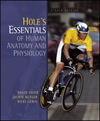 |  Hole's Essentials of Human Anatomy & Physiology, 8/e David N. Shier,
Washtenaw Community College
Jackie L. Butler,
Grayson County College
Ricki Lewis,
SUNY - Albany
What's NewHole's Essentials of Human Anatomy and Physiology is written with the student in mind.
Several new features accompany the eighth edition.
Key Term Pronunciations within the Text
A list of key terms and their phonetic pronunciations at the beginning of each chapter helps build
science vocabulary. The key terms are boldfaced, defined within the chapter and followed again
by pronunciations when the term is first introduced in the text. These terms are likely to be
found in subsequent chapters. The glossary at the end of the book explains phonetic
pronunciations.
Chapter Opening Vignettes
The authors provide interesting, creative, and thought-provoking vignettes that introduce the
chapter topics.
Check Your Recall Review Questions
This edition offers review questions at the ends of major sections in each chapter to test
understanding of the material just covered.
Design
The revitalized text design injects new life into the study of Anatomy and Physiology. Bright,
bold, modern colors are used throughout the feature boxes, tables, and chapter openers making
them easy to recognize.
Illustrations
The new art program is designed to support the text and beyond. Labels and legends go only as
far as the text itself. However, the detail of the figures is accurate enough to support more
detailed discussion if the instructor or the student chooses further investigation.
Facts of Life
These briefs are fun bits of A&P trivia information scattered throughout the text adding a touch
of wonder to chapter topics and concepts.
Clinical Connections
These new clinical connections are integrated at the end of several chapters to "pull the concepts
together". The short vignettes help students make a vital real-life connection to the chapter
material.
Review Exercises and Critical Thinking
End-of-chapter review exercises have been updated to help the student check their
understanding of the chapter's major ideas. Critical thinking questions encourage you to apply
information to clinical situations.
Web Connections
This end-of-chapter feature directs students to helpful online websites that will promote greater
understanding of chapter content.
Online Learning Center
New OLC activities and resources are available for students and instructors.
Digital Content Manager
This multimedia collection of visual resources allows instructors to utilize artwork from the text in
multiple formats to create customized classroom presentations, visually-based tests and quizzes,
dynamic course website content, or attractive printed support materials. The digital assets on
this cross-platform CD-ROM are grouped by chapter within the following easy-to-use folders.
Active Art Library Key Process Figures from the text are
saved in manipulable layers that can be isolated and customized to meet the needs of the lecture
environment.
Animations Library Numerous full-color animations of key physiological
processes are provided. Harness the visual impact of processes in motion by importing these
files into classroom presentations or course websites.
Art Libraries Full-color digital files of all illustrations in the book, plus the
same art saved in unlabeled and gray scale versions, can be readily incorporated into lecture
presentations, exams, or custom-made classroom materials. These images are also pre-
inserted into blank PowerPoint slides for ease of use.
Photo Libraries Digital files of instructionally significant photographs from
the text—including cadaver, bone, histology, and surface anatomy images—can be reproduced
for multiple classroom uses.
PowerPoint Lectures Ready-made presentations that combine art and
lecture notes have been specifically written to cover each of the 29 chapters of the text. Use the
PowerPoint lectures as they are, or tailor them to reflect your preferred lecture topics and
sequences.
Tables Library Every table that appears in the text is provided in electronic
form.
|
|



 2003 McGraw-Hill Higher Education
2003 McGraw-Hill Higher Education